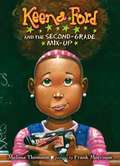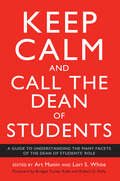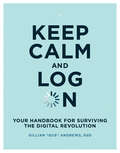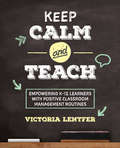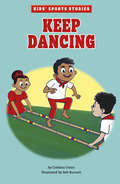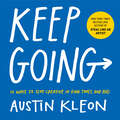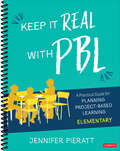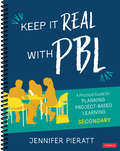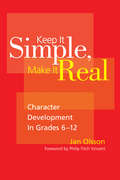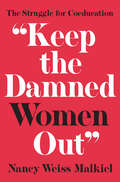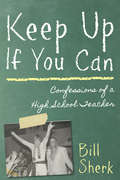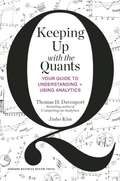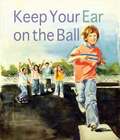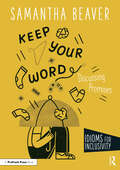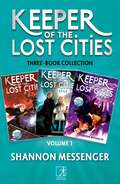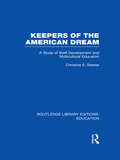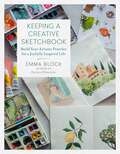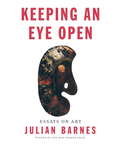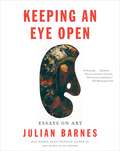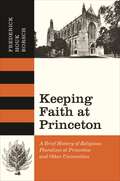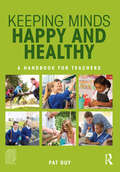- Table View
- List View
Keena Ford and the Second Grade Mix-up
by Melissa Thomson Frank MorrisonMeet an irrepressible young lady with a flair for getting into trouble! Sassy, fun-loving Keena Ford always tries to do the right thing, but somehow, she just keeps making things worse. Keena is super excited about starting second grade and she's eager to impress her new teacher, but why does Ms. Hanson think Keena's birthday is tomorrow? It was a small mistake, but now Keena can't turn down her very own chocolate cake and sparkly crown, can she? No more than she can help sneaking into her best friend Eric's classroom to see if it's really as much fun as he claims. Too bad nothing turns out quite the way she plans... This laugh-out-loud book by first-time author Melissa Thomson has short chapters and lively illustrations, making it perfect for beginning readers.
Keep Calm and Call the Dean of Students: A Guide to Understanding the Many Facets of the Dean of Students' Role
by Art Munin Lori S. WhiteThe role of Dean of Students is pivotal: in students’ lives; for their institutions as a conduit to senior administration about issues of concern to students; as a figure who can coordinate disparate campus constituencies -- from academic affairs and athletics to campus safety and relationships with parents and alums; and as a crisis manager.What preparation, skills, dispositions, and knowledge do DOSs need to be effective in their role; and, indeed, what areas and range of activities generally fall under their responsibility?Through chapters by experienced DOSs – from early career to veterans and in between – this book provides vivid first-hand accounts of what’s involved in managing the multiple roles of the deanship, its immense personal rewards, the positive impact that practitioners can make in the lives of students, and on campus policy and environment, without glossing over the demands on time and the concomitant stresses. The contributors describe the paths they followed to take on the role, and what they do to keep current.Each chapter offers a wealth of anecdotes that provide an insider’s feel for the daily life of the DOS, and how incumbents have found ways to integrate family and personal needs with the discharging of their often demanding responsibilities. The contributing authors offer valuable advice on setting priorities and dealing with issues as varied as setting budgets, creating an effective team, delegation, and addressing student conduct issues. They offer guidance on developing allies across campus, keeping up to date with trends and legislation, and building a network of mentors and advisors through professional associations and connection with their peers at institutions around the country. The book concludes with some perspectives about the meaning and purpose of the dean of students role in our current era and as we look to the future of higher education.The dean of students is a challenging role because it is often the one administrator thrust onto the frontlines to meet students not only at their best, but also at their worst. This person is an advocate and educator, disciplinarian and friend, confidant and counselor, and advisor and parent all rolled into one. Keep Calm and Call the Dean of Students offers a unique window into this challenging and rewarding position that will appeal to sitting deans; to those seeking this role; and to senior leaders in higher education seeking to appoint a DOS and/or organize a dean of students portfolio of responsibilities.
Keep Calm and Log On: Your Handbook for Surviving the Digital Revolution
by Gillian "Gus" AndrewsHow to survive the digital revolution without getting trampled: your guide to online mindfulness, digital self-empowerment, cybersecurity, creepy ads, trustworthy information, and more.Feeling overwhelmed by an avalanche of online content? Anxious about identity theft? Unsettled by the proliferation of fake news? Welcome to the digital revolution. Wait—wasn't the digital revolution supposed to make our lives better? It was going to be fun and put the world at our fingertips. What happened? Keep Calm and Log On is a survival handbook that will help you achieve online mindfulness and overcome online helplessness—the feeling that tech is out of your control—with tips for handling cybersecurity, creepy ads, untrustworthy information, and much more.Taking a cue from the famous World War II morale-boosting slogan (“Keep Calm and Carry On”), Gus Andrews shows us how to adapt the techniques our ancestors used to survive hard times, so we can live our best lives online. She explains why media and technology stress us out, and offers empowering tools for coping. Mindfulness practices can help us stay calm and conserve our attention purposefully. Andrews shares the secret of understanding our own opinions'' “family trees” in order to identify misleading “fake news.” She provides tools for unplugging occasionally, overcoming feelings that we are “bad at technology,” and taking charge of our security and privacy. Andrews explains how social media algorithms keep us from information we need and why “creepy ads” seem to follow us online. Most importantly, she urges us to work to rebuild the trust in our communities that the internet has broken.
Keep CALM and Teach: Empowering K-12 Learners With Positive Classroom Management Routines (Corwin Teaching Essentials)
by Victoria S. LentferWhat do you say when . . . More than ever before, students are coming to school with social, emotional, and behavioral issues that could have a negative impact on their learning. What’s more, the pressure on teachers for their students to perform well on high-stakes testing can take the focus away from addressing behavioral issues. Luckily, there’s a practical solution for managing behavior in the classroom. Get to know the CALM method—an actionable, clear, and easy to remember framework for redirecting student behavior. CALM stands for Communication, Accountability, Leadership, and Motivation. It is an inclusive approach to behavior focused on building relationships, community, behavior skills, and academic achievement. The CALM framework provides teachers with successful behavior strategies that will create a comfortable, safe, respectful, and encouraging learning environment for students and teachers alike. Whether you’re new to teaching, working with at-risk students, or you’ve been working in the profession for years but want a fresh approach, this book will provide you with Strategies to inspire a CALM classroom Positive ways to redirect inappropriate behavior Practical scripts to answer the question "What do I say when _______ happens?" Step-by-step guides, checklists, and templates for ensuring a productive, engaging classroom community Developing classroom management skills and techniques that work can be extremely challenging, but it doesn’t have to be. Keep CALM with proactive strategies for creating a culture of respect, accountability, and a strong sense of community!
Keep CALM and Teach: Empowering K-12 Learners With Positive Classroom Management Routines (Corwin Teaching Essentials)
by Victoria S. LentferWhat do you say when . . . More than ever before, students are coming to school with social, emotional, and behavioral issues that could have a negative impact on their learning. What’s more, the pressure on teachers for their students to perform well on high-stakes testing can take the focus away from addressing behavioral issues. Luckily, there’s a practical solution for managing behavior in the classroom. Get to know the CALM method—an actionable, clear, and easy to remember framework for redirecting student behavior. CALM stands for Communication, Accountability, Leadership, and Motivation. It is an inclusive approach to behavior focused on building relationships, community, behavior skills, and academic achievement. The CALM framework provides teachers with successful behavior strategies that will create a comfortable, safe, respectful, and encouraging learning environment for students and teachers alike. Whether you’re new to teaching, working with at-risk students, or you’ve been working in the profession for years but want a fresh approach, this book will provide you with Strategies to inspire a CALM classroom Positive ways to redirect inappropriate behavior Practical scripts to answer the question "What do I say when _______ happens?" Step-by-step guides, checklists, and templates for ensuring a productive, engaging classroom community Developing classroom management skills and techniques that work can be extremely challenging, but it doesn’t have to be. Keep CALM with proactive strategies for creating a culture of respect, accountability, and a strong sense of community!
Keep Dancing (Kids' Sports Stories)
by Cristina OxtraLito is proud of his Filipino heritage, and he's one of the best dancers in his folk dance group. He and his sister, Nenita, plan to perform at their school's spring festival. When snickering classmates threaten to derail Lito's confidence, he needs to dig deep and keep dancing.
Keep Going: 10 Ways to Stay Creative in Good Times and Bad (Austin Kleon Ser.)
by Austin KleonKeep Working. Keep Playing. Keep Creating. In his previous books Steal Like an Artist and Show Your Work!, both New York Times bestsellers, Austin Kleon gave readers the keys to unlock their creativity and showed them how to become known. Now he offers his most inspiring work yet, with ten simple rules for how to stay creative, focused, and true to yourself—for life. The creative life is not a linear journey to a finish line, it’s a loop—so find a daily routine, because today is the only day that matters. Disconnect from the world to connect with yourself—sometimes you just have to switch into airplane mode. Keep Going celebrates getting outdoors and taking a walk (as director Ingmar Bergman told his daughter, ”The demons hate fresh air”). Pay attention, and especially pay attention to what you pay attention to. Worry less about getting things done, and more about the worth of what you’re doing. Instead of focusing on making your mark, work to leave things better than you found them.Keep Going and its timeless, practical, and ethical principles are for anyone trying to sustain a meaningful and productive life.
Keep It Real With PBL, Elementary: A Practical Guide for Planning Project-Based Learning (Corwin Teaching Essentials Ser.)
by Jennifer PierattPlan enriching Project-Based Learning experiences with ease! If discovering a clear and efficient project-planning process is on your list, prepare to cross it off! This practical guide will help you design and construct project-based learning (PBL) experiences that facilitate deeper learning and develop 21st century skills for your students. Covering steps in the process such as brainstorming, benchmarking, and assessments, this accessible book also features: • #realtalk soundbites that honor the challenges to implementing PBL • Tips and resources to support the project-planning process • Planning forms to guide you through planning your projects • Exercises to help you reflect and process throughout your project plans
Keep It Real With PBL, Elementary: A Practical Guide for Planning Project-Based Learning (Corwin Teaching Essentials Ser.)
by Jennifer PierattPlan enriching Project-Based Learning experiences with ease! If discovering a clear and efficient project-planning process is on your list, prepare to cross it off! This practical guide will help you design and construct project-based learning (PBL) experiences that facilitate deeper learning and develop 21st century skills for your students. Covering steps in the process such as brainstorming, benchmarking, and assessments, this accessible book also features: • #realtalk soundbites that honor the challenges to implementing PBL • Tips and resources to support the project-planning process • Planning forms to guide you through planning your projects • Exercises to help you reflect and process throughout your project plans
Keep It Real With PBL, Secondary: A Practical Guide for Planning Project-Based Learning (Corwin Teaching Essentials Ser.)
by Jennifer PierattLet’s Get Real About PBL Does project-based learning (PBL) feel just out of reach in in your secondary classroom? Is project-planning an overwhelming project in and of itself? Dr. Jennifer Pieratt, a consultant and former teacher, knows firsthand how challenging designing projects can be, especially for secondary teachers with large caseloads and short class periods to engage in meaningful teaching and learning. In this hands-on, interactive guide, Pieratt supports secondary teachers through the iterative process of planning authentic project-based learning experiences. Using backward design, she gives teachers ready to use strategies for identifying the best concepts to tackle in PBL experiences, brainstorming realistic projects, facilitating meaningful learning, and creating formative and summative assessments. The book is visually accessible in style and features #realtalk soundbites that tackle the challenges to implementing PBL Tips and resources to support the project-planning process Planning forms to guide you through planning your projects Key terminology and acronyms in PBL Exercises to help you reflect and process throughout your project plans Master PBL planning with this clear, efficient, and easy-to-use guide to creating enriching experiences for your students!
Keep It Real With PBL, Secondary: A Practical Guide for Planning Project-Based Learning (Corwin Teaching Essentials Ser.)
by Jennifer PierattLet’s Get Real About PBL Does project-based learning (PBL) feel just out of reach in in your secondary classroom? Is project-planning an overwhelming project in and of itself? Dr. Jennifer Pieratt, a consultant and former teacher, knows firsthand how challenging designing projects can be, especially for secondary teachers with large caseloads and short class periods to engage in meaningful teaching and learning. In this hands-on, interactive guide, Pieratt supports secondary teachers through the iterative process of planning authentic project-based learning experiences. Using backward design, she gives teachers ready to use strategies for identifying the best concepts to tackle in PBL experiences, brainstorming realistic projects, facilitating meaningful learning, and creating formative and summative assessments. The book is visually accessible in style and features #realtalk soundbites that tackle the challenges to implementing PBL Tips and resources to support the project-planning process Planning forms to guide you through planning your projects Key terminology and acronyms in PBL Exercises to help you reflect and process throughout your project plans Master PBL planning with this clear, efficient, and easy-to-use guide to creating enriching experiences for your students!
Keep It Simple, Make It Real: Character Development in Grades 6-12
by Jan OlssonA realistic approach to assessing student behavior, staff morale, and school climate and creating a proven-to-work character development program that can dramatically turn around student behavior.
"Keep the Damned Women Out": The Struggle for Coeducation (The William G. Bowen Memorial Series in Higher Education)
by Nancy Weiss MalkielAs the tumultuous decade of the 1960s ended, a number of very traditional, very conservative, highly prestigious colleges and universities in the United States and the United Kingdom decided to go coed, seemingly all at once, in a remarkably brief span of time. Coeducation met with fierce resistance. As one alumnus put it in a letter to his alma mater, "Keep the damned women out." Focusing on the complexities of institutional decision making, this book tells the story of this momentous era in higher education--revealing how coeducation was achieved not by organized efforts of women activists, but through strategic decisions made by powerful men.In America, Ivy League schools like Harvard, Yale, Princeton, and Dartmouth began to admit women; in Britain, several of the men's colleges at Cambridge and Oxford did the same. What prompted such fundamental change? How was coeducation accomplished in the face of such strong opposition? How well was it implemented? Nancy Weiss Malkiel explains that elite institutions embarked on coeducation not as a moral imperative but as a self-interested means of maintaining a first-rate applicant pool. She explores the challenges of planning for the academic and non-academic lives of newly admitted women, and shows how, with the exception of Mary Ingraham Bunting at Radcliffe, every decision maker leading the charge for coeducation was male.Drawing on unprecedented archival research, "Keep the Damned Women Out" is a breathtaking work of scholarship that is certain to be the definitive book on the subject.
Keep Up If You Can: Confessions of a High School Teacher
by Bill SherkA light-hearted and touching memoir of Bill Sherk’s 30-plus-year career as a Toronto high school history teacher with a creative flair and passion for his work. Bill Sherk taught history to Toronto high school students for more than thirty years. With his dynamic, creative, and occasionally unorthodox teaching style, he instilled in his students a passion for history and learning. Sherk was loved by his students and remained in their memories long after graduation.Keep Up If You Can is a light-hearted and touching memoir that will appeal to anyone who’s had a special teacher impact their life.Fun facts:He learned the names of all his students on the first day of school.He assigned ancient names to his ancient history students. They called him Sherkules (SHERK-yoo-leez).After reading Webster’s Dictionary cover to cover, he encouraged his students to coin new words, and many of these were published in his three dictionaries.Firmly believing in physical activity, he would leap atop his desk and lead his students in an aerobic "Sherkout" to a rock-and-roll beat.
Keep Your Ear on the Ball
by Genevieve PetrilloFrom the book Jacket: Everybody wants to help Davey. "Let me open that." "Do you want to hold my hand?" Davey has one answer for all, "Thanks, but no thanks." Davey is blind-and he is perfectly capable of doing everything on his own. His well-meaning classmates stop offering help when they see how able Davey is. They respect his selfreliance-until he tries to play kickball. After several missed kicks and a trampled first baseman, no one wants Davey on his or her team. But by working together, the children figure out a way to offer help that respects Davey's unique abilities and his desire for freedom. In this seamless tale, based on a true story, the children realize that interdependence can be just as important and rewarding as independence.
Keep Your Word: Discussing Promises (Idioms for Inclusivity)
by Samantha BeaverTo get the complete Idioms for Inclusivity experience, this book can be purchased alongside four others as a set, Idioms for Inclusivity: Fostering Belonging with Language, 978-1-032-28635-8. Informed by sociolinguistic research, yet written accessibly, Keep Your Word challenges readers to investigate the act of promising as it relates to both language-use and inclusivity. This engaging and delightfully illustrated book invites students to engage with concepts such as: the cultural meaning of the idiom "keep your word", Speech Acts and Felicity Conditions, two frameworks that linguists use to research and understand promises, why the expectation to "keep your word" can make someone feel excluded, and how understanding the way language works can help learn to be more inclusive. Featuring practical inclusivity tips related to promises, this enriching curriculum supplement can be used in a Language Arts setting to learn about figurative language; in a Social Studies setting to discuss diversity, equity, inclusion, and belonging; or as an introduction to linguistics for students ages 7-14.
Keeper of the Lost Cities Collection: Keeper of the Lost Cities, Exile and Everblaze (Keeper of the Lost Cities)
by Shannon MessengerJump into the epic world of the Lost Cities with this exclusive bundle of the first THREE books in Shannon Messenger's bestselling series! In the electrifying Keeper of the Lost Cities, twelve-year-old Sophie Foster, who has the power to read minds, is forced to leave behind everything she knows and start a new life in the magical world of the Lost Cities, full of other people with incredible powers. Exile sees Sophie settling in to her new life in the Lost Cities – but danger is still afoot. Sophie must risk everything to find the answers to questions that could save not only her life, but the life of someone close to her . . . The nail-biting third book in the series, Everblaze, follows Sophie and her friends as they uncover shocking secrets and face treacherous new enemies . . .Also in the Keeper of the Lost Cities series:Neverseen Lodestar Nightfall Flashback Legacy
Keepers of the American Dream: A Study of Staff Development and Multicultural Education (Routledge Library Editions: Education)
by Christine E. SleeterThis book reports an ethnographic study of thirty teachers from eighteen schools who participated in a staff development programme in multicultural education. The study examines how multicultural education was actually presented to teachers, and areas in which their classroom teaching and perception of students changed over the two-year period. Although most of the teachers reported learning a good deal, changes in their teaching and their discussions of teaching were fairly limited. After reporting the data, the book examines why changes were limited, analyzing three areas: the nature of staff development and how multicultural education was packaged; the structure of schools as institutions; and the identities and life experiences of teachers as White women, often from working class backgrounds.
Keeping a Creative Sketchbook: Build Your Artistic Practice for a Joyfully Inspired Life
by Emma BlockAn inspiring creativity guide for keeping a sketchbook as an artistic practice, with techniques and sources of inspiration for experimenting, drawing, painting, and seeing the world through a colorful lens, from watercolor artist and author of The Joy of Watercolor Emma Block Keeping a sketchbook is a wonderfully rewarding pursuit for artists and hobbyists alike. Your sketchbook is a safe place to explore, experiment, try new things, record your progress, and sometimes mess up, and working in a sketchbook, particularly on location, is an innately mindful practice. You become completely focused on the things you are sketching or painting and completely immersed in the atmosphere of the place. In Keeping a Creative Sketchbook, Emma Block shares her own sketchbook practice and offers inspiring artist interviews and numerous techniques and practices for beginning or transforming your own. Packed with ideas and prompts to get started, this book helps overcome overwhelm and open a world of joyful creativity. With your sketchbook by your side, you can slow down, be present, notice the little things, enjoy the process, let go of perfectionism, and embrace the blank page, discovering rich new depths to your creativity and finding your artist mindset for inner peace.
Keeping an Eye Open
by Julian BarnesAn extraordinary collection--hawk-eyed and understanding--from the Booker Prize-winning, bestselling author of The Sense of an Ending and Levels of Life. As Julian Barnes explains: "Flaubert believed that...great paintings required no words of explanation. Braque thought the ideal state would be reached when we said nothing at all in front of a painting... But it is a rare picture which stuns, or argues, us into silence. And if one does, it is only a short time before we want to explain and understand the very silence into which we have been plunged." This is the exact dynamic that informs his new book. Barnes, in his 1989 novel A History of the World in 10 1/2 Chapters, had a chapter on Géricault's The Raft of the Medusa, and since then he has written about many great masters of nineteenth- and twentieth-century art, including Delacroix, Manet, Fantin-Latour, Cezanne, Degas, Redon, Bonnard, Vuillard, Vallotton, Braque, Magritte, Oldenburg, Howard Hodgkin and Lucian Freud. The seventeen essays gathered here are adroit, insightful and, above all, a true pleasure to read.
Keeping an Eye Open: Essays on Art
by Julian BarnesAn extraordinary collection--hawk-eyed and understanding--from the Man Booker Prize-winning, best-selling author of The Sense of an Ending and Levels of Life. As Julian Barnes notes: "Flaubert believed that it was impossible to explain one art form in terms of another, and that great paintings required no words of explanation. Braque thought the ideal state would be reached when we said nothing at all in front of a painting . . . But it is a rare picture that stuns, or argues, us into silence. And if one does, it is only a short time before we want to explain and understand the very silence into which we have been plunged." This is the exact dynamic that informs his new book. In his 1989 novel A History of the World in 10½ Chapters, Barnes had a chapter on Géricault's The Raft of the Medusa, and since then he has written about many great masters of nineteenth- and twentieth-century art, including Delacroix, Manet, Fantin-Latour, Cézanne, Degas, Redon, Bonnard, Vuillard, Vallotton, Braque, Magritte, Oldenburg, Lucian Freud and Howard Hodgkin. The seventeen essays gathered here help trace the arc from Romanticism to Realism and into Modernism; they are adroit, insightful and, above all, a true pleasure to read.From the Hardcover edition.
Keeping Faith at Princeton: A Brief History of Religious Pluralism at Princeton and Other Universities
by Frederick Houk BorschAn inside look at how religious diversity came to PrincetonIn 1981, Frederick Houk Borsch returned to Princeton University, his alma mater, to serve as dean of the chapel at the Ivy League school. In Keeping Faith at Princeton, Borsch tells the story of Princeton's journey from its founding in 1746 as a college for Presbyterian ministers to the religiously diverse institution it is today. He sets this landmark narrative history against the backdrop of his own quest for spiritual illumination, first as a student at Princeton in the 1950s and later as campus minister amid the turmoil and uncertainty of 1980s America.Borsch traces how the trauma of the Depression and two world wars challenged the idea of progress through education and religion—the very idea on which Princeton was founded. Even as the numbers of students gaining access to higher education grew exponentially after World War II, student demographics at Princeton and other elite schools remained all male, predominantly white, and Protestant. Then came the 1960s. Campuses across America became battlegrounds for the antiwar movement, civil rights, and gender equality. By the dawn of the Reagan era, women and blacks were being admitted to Princeton. So were greater numbers of Jews, Catholics, and others. Borsch gives an electrifying insider's account of this era of upheaval and great promise.With warmth, clarity, and penetrating firsthand insights, Keeping Faith at Princeton demonstrates how Princeton and other major American universities learned to promote religious diversity among their students, teachers, and administrators.
Keeping Languages Alive
by Mari C. Jones Sarah OgilvieMany of the world's languages have diminishing numbers of speakers and are in danger of falling silent. Around the globe, a large body of linguists are collaborating with members of indigenous communities to keep these languages alive. Mindful that their work will be used by future speech communities to learn, teach and revitalise their languages, scholars face new challenges in the way they gather materials and in the way they present their findings. This volume discusses current efforts to record, collect and archive endangered languages in traditional and new media that will support future language learners and speakers. Chapters are written by academics working in the field of language endangerment and also by indigenous people working 'at the coalface' of language support and maintenance. Keeping Languages Alive is a must-read for researchers in language documentation, language typology and linguistic anthropology.
Keeping Minds Happy and Healthy: A handbook for teachers
by Pat GuyKeeping Minds Happy and Healthy is a practical resource for teachers and shows how pupils can achieve and maintain excellent mental health. It focuses on identifying the main causes of unhappiness, stress and anxiety, by examining the difficulties a school system can inadvertently create for pupils. By developing resilience, empathic behaviour, social skills and self respect during childhood, pupils will better equipped to withstand the pressures of modern society and growing up. With practical tip sheets and advice Keeping Minds Happy and Healthy suggests ways to create a more positive educational experience for all pupils. Pat Guy shows how schools can increase all pupils’ well-being, enabling them to deal with the challenging situations they face as they move through education and into the adult world.
